This article relies largely or entirely on a single source .(December 2024) |
This article relies largely or entirely on a single source .(December 2024) |
The mosque was constructed in 1702 by Rustam Dil Khan, the Mughal governor of Hyderabad. [1]
The small mosque is built in the Qutb Shahi style, with three arches opening into the courtyard. An ablution tank is situated in the courtyard. Beyond the ablution tank are the graves of Jan Sipar Khan and Rustam Dil Khan. [1]
The date of the mosque's construction is given in an inscription over the mihrab. [1]
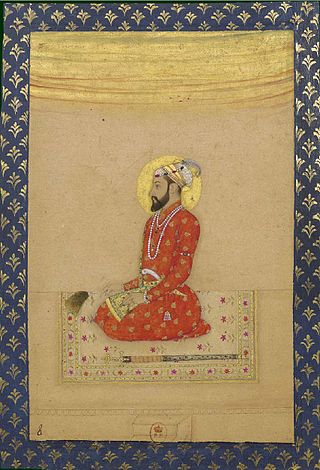
Mirza Muhammad Mu'azzam, commonly known as Bahadur Shah I and Shah Alam I, was the eighth Mughal Emperor from 1707 to 1712. He was the second son of the sixth Mughal emperor Aurangzeb, who he conspired to overthrow in his youth. He was also governor of the imperial provinces of Agra, Kabul and Lahore and had to face revolts of Rajputs and Sikhs.

The Charminar is a monument located in Hyderabad, Telangana, India. Constructed in 1591, the landmark is a symbol of Hyderabad and officially incorporated in the emblem of Telangana. The Charminar's long history includes the existence of a mosque on its top floor for more than 425 years. While both historically and religiously significant, it is also known for its popular and busy local markets surrounding the structure, and has become one of the most frequented tourist attractions in Hyderabad. Charminar is also a site of numerous festival celebrations, such as Eid-ul-adha and Eid al-Fitr, as it is adjacent to the city's main mosque, the Makkah Masjid.

Nizam of Hyderabad was the title of the ruler of Hyderabad State. Nizam is a shortened form of Niẓām ul-Mulk, and was the title bestowed upon Asaf Jah I when he was appointed Viceroy of the Deccan by the Mughal Emperor Farrukhsiyar. In addition to being the Mughal Viceroy (Naib) of the Deccan, Asaf Jah I was also the premier courtier of the Mughal Empire until 1724, when he established an independent realm based in Hyderabad, but in practice, continued to recognise the nominal authority of emperor.
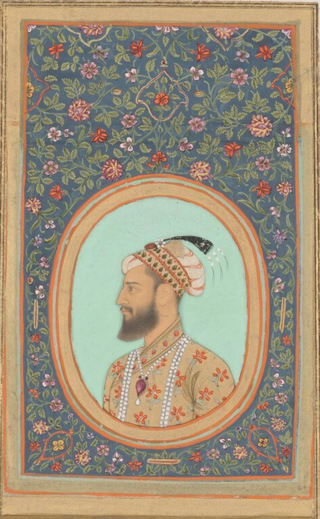
Mirza Muhammad Kam Bakhsh was the youngest son of Mughal emperor Aurangzeb, born to his wife Udaipuri Mahal.

The Sunehri Mosque, also known as the Talai Mosque, is a late Mughal architecture-era mosque in the Walled City of Lahore, capital of the Pakistani province of Punjab.

Asaf Jah VI, also known as Sir Mir Mahboob Ali Khan Siddiqi, was the sixth Nizam of Hyderabad. He ruled Hyderabad State, one of the princely states of India, between 1869 and 1911.
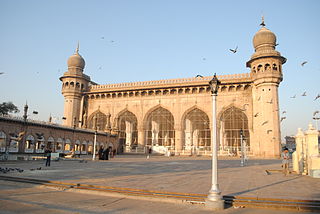
Makkah Masjid or Mecca Masjid, is a congregational mosque in Hyderabad, India. It is the largest mosque in the city, and one of the largest in the country, with a capacity of 10,000 people. The mosque was built during the 17th century, and is a state-protected monument. It serves as the primary mosque for the Old City of Hyderabad, and is located close to the historic landmarks of Charminar, Chowmahalla Palace and Laad Bazaar.

Daud Khan Panni or simply Daud Khan, was a Pashtun nobleman and military commander of the Mughal Empire. Historians Muzaffar Alam and Sanjay Subrahmanyam characterise him as an important figure of Mughal history spanning the later years of emperor Aurangzeb, to the early rule of Farrukhsiyar.

The Taj-ul-Masajid or Tāj-ul-Masjid, is a mosque situated in Bhopal, Madhya Pradesh, India. It is the largest mosque in India and one of the largest mosques in the world.
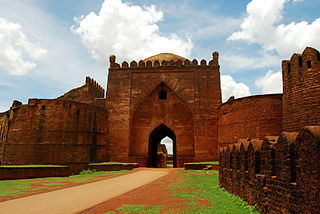
Bidar Fort is located in old city area, Bidar, Karnataka, India. The fort, the city and the district are all affixed with the name Bidar. Sultan Ahmad Shah I of the Bahmanid dynasty shifted his capital from Gulbarga to Bidar in 1427 and built his fort along with a number of Islamic monuments. There are over 30 monuments inside Bidar fort.

The Old City of Hyderabad is a walled city of Hyderabad, Telangana, India, located on the banks of the Musi River built by Qutb Shahi sultan Muhammed Quli Qutb Shah in 1591 AD. There used to be a wall surrounding the Old City, most of which is destroyed. Mubariz Khan, the Mughal governor of Deccan Subah, had fortified the city in 1712 and was completed by Nizam of Hyderabad.

Hayat Bakshi Mosque also Hayat Bakshi Begum Masjid is a mosque located in Hayathnagar, near Hyderabad, India. It was constructed in 1672 during the reign of Abdullah Qutb Shah the fifth Sultan of Golconda, and named after Hayat Bakshi Begum.

Toli Masjid, also known as Damri Masjid, is a mosque in Hyderabad, in the Indian state of Telangana. It was constructed during the Qutb Shahi period and completed in 1671.
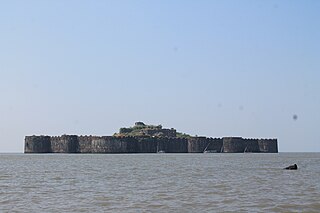
The Deccan sultanates were five early modern kingdoms, namely Bijapur, Golkonda, Ahmadnagar, Bidar, and Berar, which ruled the Deccan Plateau for part of the 15th, and the majority of the 16th–17th centuries. Their architecture was a regional variant of Indo-Islamic architecture, and influenced by the styles of the Delhi Sultanate and later Mughal architecture, but sometimes also influenced from Persia and Central Asia. Hindu temple architecture in the same areas had very different styles.
The Mughal war of succession (1707–1709) or the Mughal Civil War was a period of political disorder and armed conflict over succession in the Mughal Empire following the death of the sixth Mughal emperor Aurangzeb in March 1707.

The Musheerabad Masjid or Masjid e Kalan, is a mosque located in the Musheerabad locality of Hyderabad, India. The original portion was constructed in 1560 AD by Ibrahim Quli Qutb Shah, the fourth Sultan of the Qutb Shahi dynasty and is identical to the Hayat Bakshi Mosque located in Hayathnagar area of Hyderabad.
Hyderabad Subah, also known as Golconda Subah, was a province of the Mughal Empire encompassing the eastern Deccan region of the Indian subcontinent. It was created in 1687, during the reign of Mughal emperor Aurangzeb, by the annexation of the Golconda Sultanate. Hyderabad Subah later began to secede in the 18th century, as the Mughal Empire declined and became fully independent as part of the Nizam-administered Deccan.
Rustam Dil Khan was a noble of the Mughal Empire during the reign of emperor Aurangzeb. His activities were centred around the Mughal province of Hyderabad Subah, which he administered as deputy subahdar (governor) for most of his official career. He was killed by prince Kam Bakhsh during the war of succession after Aurangzeb's death, as the prince attempted a bid for independent rule in the Deccan. He is buried in the Kali Masjid, a mosque he built in the city of Hyderabad.
Mir Bahadur Dil, known by the title Jan Sipar Khan, was a noble of the Mughal Empire. He was active during the reign of emperor Aurangzeb, and held offices in the Deccan region of the empire. His most notable position was in the Mughal province of Hyderabad Subah, where he served as its first permanent subahdar (governor) for twelve years, dying in office.